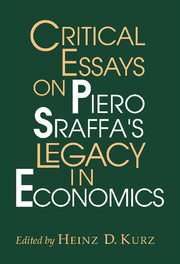Book contents
- Frontmatter
- Contents
- Preface
- List of contributors
- Part I Introduction
- Part II Returns to scale, demand, money and interest, and the classical tradition
- Part III Long-period theory and the problem of capital
- Part IV Intertemporal equilibrium theory and the problem of capital
- 10 Paradoxes of capital and counterintuitive changes of distribution in an intertemporal equilibrium model
- 11 Savings, investment and capital in a system of general intertemporal equilibrium
- Mathematical Note by Michele Tucci
- Author index
- Subject index
10 - Paradoxes of capital and counterintuitive changes of distribution in an intertemporal equilibrium model
Published online by Cambridge University Press: 05 June 2012
- Frontmatter
- Contents
- Preface
- List of contributors
- Part I Introduction
- Part II Returns to scale, demand, money and interest, and the classical tradition
- Part III Long-period theory and the problem of capital
- Part IV Intertemporal equilibrium theory and the problem of capital
- 10 Paradoxes of capital and counterintuitive changes of distribution in an intertemporal equilibrium model
- 11 Savings, investment and capital in a system of general intertemporal equilibrium
- Mathematical Note by Michele Tucci
- Author index
- Subject index
Summary
Two parables
Is the problem of capital theory one of aggregation which only concerns macroeconomic production functions or does it apply to all versions of the neoclassical theory of distribution? The generality of the critique was often questioned around 1970, when one heard the objection: ‘Re-switching poses a problem for the marginal productivity theory of distribution, but general intertemporal equilibrium theory is not affected; Arrow and Debreu have proved the existence of equilibrium.’ The assertion is simplistic, but is still made.
C. Bliss (1970, p. 437), in an editorial comment on an article by Garegnani (Garegnani, 1970), expressed this opinion in the following form:
Prof. Garegnani in his paper makes a claim which, to economists familiar with the modern theory of general equilibrium, will seem rather surprising. He supposes an economy with many capital goods in stationary long-run equilibrium at rate of interest r*. He then asks himself whether, following a change in demand leading to ‘a tendency to positive net saving’, there exists a new equilibrium of supply and demand consistent with the new demand functions. He concludes that no such equilibrium need exist.…Now an equilibrium of supply and demand certainly might not exist, but we know from the work of G. Debreu…that the conditions required for existence are rather weak…these conditions obtain in Garegnani's model.
Bliss then criticizes the fact that Garegnani uses long-period prices where, in the transition, short-run equilibria are involved.
- Type
- Chapter
- Information
- Critical Essays on Piero Sraffa's Legacy in Economics , pp. 363 - 391Publisher: Cambridge University PressPrint publication year: 2000
- 13
- Cited by



